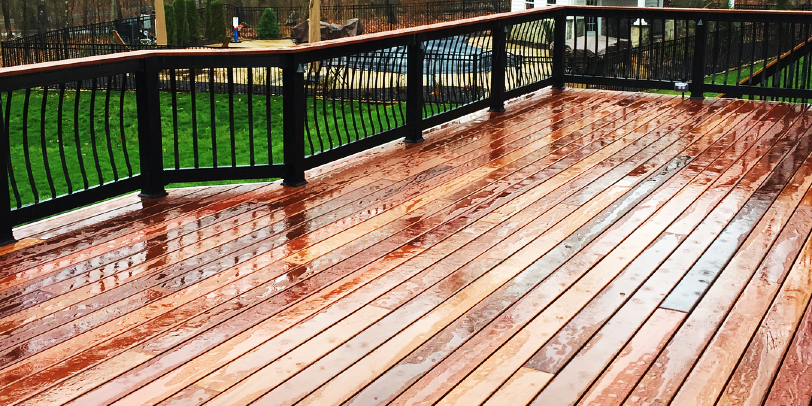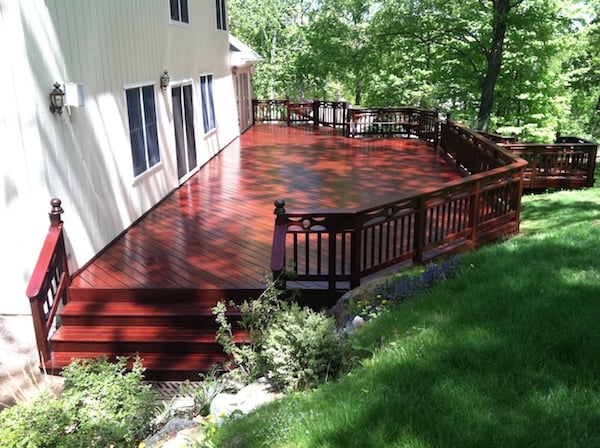A Comprehensive Guide to Various Kinds of Deck Staining Techniques for Ultimate Protection and Aesthetics
In the world of deck upkeep, the art of staining stands as a pivotal action towards both protecting the stability of your outside area and improving its visual allure. As we browse through the elaborate world of deck staining methods, one starts to appreciate the nuanced methods that can make all the distinction in between a sub-par surface and a flawless one.
Understanding Various Types of Stains
Different sorts of discolorations are typically utilized in the process of deck discoloration to accomplish different aesthetic and protective impacts. Clear spots are excellent for showcasing the all-natural grain of the wood while providing minimal protection versus UV rays and dampness. On the other hand, semi-transparent discolorations provide a balance in between color enhancement and protection, allowing some timber grain to show with. For a more nontransparent finish that supplies optimum defense against the components, solid discolorations are the preferred choice. These spots come in a variety of shades and effectively conceal the timber grain.
In addition, there are likewise specialized stains such as sealants and printer toners. Toners add a tip of shade to the timber while giving marginal protection, making them ideal for more recent decks with less wear. Sealers, on the other hand, offer defense against dampness and UV rays without including color, making them a preferred choice for decks that currently flaunt a desirable color. Recognizing the characteristics and advantages of each sort of discolor is important for accomplishing the wanted look and resilience for your deck.
Picking the Right Discoloration Color
When considering the aesthetics of your deck discoloration project, the selection of tarnish shade plays a vital duty in boosting the safety top qualities of the selected tarnish type (Beautiful Deck). The color you pick can substantially influence the overall appearance of your deck, as well as its capacity to stand up to the components gradually
When picking a discolor color, it's vital to consider the existing color pattern of your home's exterior. Integrating the deck discolor with the total aesthetic of your property can develop a aesthetically attractive and natural outside space. In addition, the shade of your deck discolor can influence the temperature level of the deck surface area; darker colors have a tendency to take in even more warmth, while lighter colors mirror sunlight and stay cooler.
Moreover, the kind of wood you are tarnishing will also influence exactly how the tarnish shade appears. Various timber varieties can communicate with the stain in different means, possibly modifying the final color. It's recommended to check the stain on a small, inconspicuous area of the deck to ensure the color ends up as desired before proceeding with the whole project.
Preparing Your Deck for Staining
To make sure a successful and lasting deck discoloration project, comprehensive preparation of the deck surface area is necessary. Begin by cleansing the deck thoroughly to get rid of dirt, crud, mildew, and any type of old finish or stain.
Inspect the deck for any harmed or rotten boards that need to be replaced. Hammer down any protruding nails and sand any harsh areas to make sure a smooth surface area for discoloration. Look for any kind of loosened barriers or actions that might need tightening or repair.
Once the deck is clean, completely dry, and in excellent repair service, consider using a wood brightener to bring back the deck's natural color and open the wood pores for far better stain infiltration. Protect any neighboring plants, furniture, or surface areas with plastic sheet prior to proceeding with the staining procedure. Correct prep work is essential to attaining a professional-looking finish and making the most of the long life of your deck tarnish.
Applying Discoloration With Different Strategies
For a professional and flawless finish, the method of using stain plays a crucial duty in enhancing the look and sturdiness of your deck. There are several special info techniques you can utilize to make sure an effective application of discolor.
Brushing is a conventional method that enables accuracy and control over the amount of stain applied. It is perfect for elaborate locations and getting to in between deck boards (Right Deck Stain). Rolling is a quicker option, covering bigger area efficiently. However, back-brushing after rolling is suggested to level the stain and work it right into the timber for better infiltration.
Splashing is an additional prominent technique, providing rate and convenience of application, particularly for huge deck areas. It is very important to utilize a high-grade sprayer and be conscious of overspray. Pad applicators offer a smooth and even complete and are suitable for both straight and upright surfaces. Whichever method you pick, making certain proper preparation and complying with maker standards will certainly assist achieve a beautiful and durable stain finish on your deck.

Maintaining and Re-staining Your Deck
Proper upkeep and prompt re-staining are essential for preserving the elegance and durability of your deck. Normal maintenance jobs consist of sweeping debris, cleaning with a deck cleaner, and checking for any type of signs of wear or damage. Addressing issues without delay can stop extra considerable issues in the future. When it comes to re-staining your deck, the frequency depends upon numerous variables such as the sort of stain utilized, the environment in your location, and just how much damage your deck experiences. Normally, it is advised to re-stain your deck every 2-4 years to maintain its defense and appearances.
Before re-staining, ensure the deck is tidy, dry, and without any type of previous stain deposit. Fining sand may be necessary to smooth out rough locations or eliminate old discolor that is flaking. Select a top quality tarnish that suits your deck's material and provides the preferred level of defense. Apply the tarnish equally using the proper strategy discussed earlier in home this guide to make sure a lovely and long-lasting coating - Water-Based Stains. By staying aggressive with upkeep and re-staining, you can delight in a aesthetically appealing and well-protected deck for several years to find.
Conclusion
In conclusion, comprehending the different kinds of deck stains, picking the ideal color, properly preparing the deck, using discolor with different methods, and preserving and re-staining the deck are necessary steps for supreme protection and appearances. By adhering to these steps, you can ensure that your deck stays in top problem for many years to find.
Additionally, the shade of your deck tarnish can affect the temperature level of the deck surface; darker colors have a tendency to take in more warmth, while lighter colors mirror sunshine and stay cooler.
It's suggested to examine the stain on a small, low-profile area of the deck to make sure the shade turns out as desired prior to continuing with the whole project.
